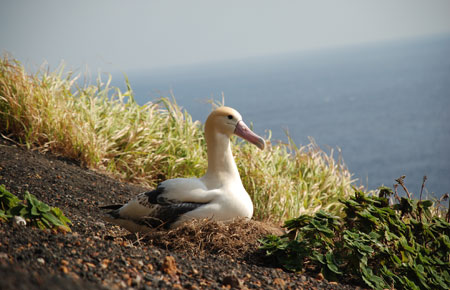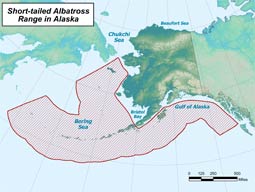Short-tailed Albatross
(Phoebastria albatrus)
Species Profile
Did You Know?
Both the male and the female short-tailed albatross incubate the egg and help rear the young.
Special Status Listing: Yes, see Status, Trends and Threats.
General Description
The short-tailed albatross is a very large seabird, with a body averaging 36 inches in length, and has long, narrow wings with an average wingspan of 7.5 feet. It has pale blue feet, and a large pink bill with a blue tip. In adult plumage it has a white back with a golden head and black and white wings. In juvenile plumage its feathers are uniformly chocolate brown. In between juvenile and adult plumages, the short-tailed albatross has several sub-adult plumages with a white face and neck and brown body. Full adult plumage is acquired at approximately 12 years of age.
Similar Species
The short-tailed albatross has several characteristics that distinguish it from the black-footed albatross and Laysan albatross, the two other albatross species that regularly occur in the North Pacific. The short-tailed albatross has a large pink bill compared to the small dark bill of the black-footed albatross and medium sized gray to yellow bill of the Laysan albatross. The short-tailed albatross is significantly larger than the other two albatross species and has a white back in adult plumage, unlike the black-footed and Laysan albatrosses.
Life History
Reproduction and Growth
Short-tailed albatrosses generally reach sexual maturity at 6-8 years of age though juveniles may make several trips to the breeding colonies prior to reaching maturity. When short-tailed albatrosses form a pair, they mate for life. They nest on the ground on volcanic ash slopes with sparse vegetation. Pairs will typically return to the same nest year after year.
Breeding begins in late October, and the female lays a single egg. Both parents take turns sitting on the nest, and the egg hatches after about 65 days in December-January. After hatching, the parents feed the chick a mixture of stomach oil and regurgitated food. When the chicks are older, their parents will bring them squid, flying fish, and crustaceans.
Short-tailed albatross chicks are dark brown with flesh-colored legs. They will not fully reach adult coloration until 12 years of age. During the transition, the juvenile short-tailed albatross will take on a mottled pattern that may resemble the adult form of other albatross species.
Feeding Ecology
Short-tailed albatross feed at the water surface. Target prey includes squid, crustaceans, and fish. When hunting squid, it generally feeds at night. squid, it generally feeds at night.
Migration
Short-tailed albatrosses migrate in the fall. They generally reach the nesting colonies in October. Non-breeding individuals and failed breeding pairs leave the colonies during the winter and spring to range throughout the North Pacific Ocean. Successful breeders will remain in the nesting colonies until May or June. The chicks fledge shortly after their parents leave the breeding grounds.
Range and Habitat
During the breeding season, nesting short-tailed albatross can be found in several colonies in small island groups south of Japan. As of 2008 approximately 85% of short-tailed albatross breed in one colony on the slopes of the volcanic Torishima Island in Japan. Short-tailed albatross have also been seen on Midway Island in the Hawaiian Islands during the breeding season. When the short-tailed albatross is not nesting, it is widespread throughout the temperate and subarctic regions of the North Pacific. The population ranges from Japan east to the Bering Sea and Gulf of Alaska and south to California. The birds are typically found near islands and mainland coastlines as opposed to mid-ocean regions. This species spends a vast majority of its time soaring over the ocean, only coming to land to nest.
Status, Trends, and Threats
Status
Worldwide numbers of short-tailed albatross are very low compared to its historic abundance. There are only a few active breeding colonies for this species. It is listed as endangered throughout its range under the Endangered Species Act (ESA). It is also listed as an endangered species by the State of Alaska. To learn more, visit the ADF&G Special Status page for short-tailed albatross.
NatureServe:
Global – G1 (critically imperiled)
State – S1N (critically imperiled, nonbreeding population)
IUCN: Vulnerable
ESA: Endangered
Trends
Once the most common albatross in the North Pacific, the short-tailed albatross was hunted to near extinction in the early 1900s. In the 1930s a volcanic eruption at their single active breeding colony further decimated the population. In 1949, the species was thought to be extinct. However, in 1950, juveniles that had survived at sea returned to their natal colonies and began breeding. Following their dramatic decline, and with the threat of feather hunters removed, the short-tailed albatross appears to be recovering. The population is small but increasing.
Threats
One of the main threats to this species is habitat loss. Their main nesting colony is located on an active volcanic island. Previous eruptions have resulted in declines in the population and loss of suitable nesting habitat. The habitat that remains is unstable and more vulnerable to storm disturbance. Further eruptions could worsen the situation.
Interaction with fisheries is another known source of mortality for this species. short-tailed albatrosses are sometimes hooked or entangled in longline fishing gear and drowned. They also drown in abandoned fishing gear left floating in the ocean. In Alaska, streamers deployed on longline fishing vessels has led to a major reduction in the bycatch of albatrosses.
The short-tailed albatross is also vulnerable to pollution. This species frequently ingests plastic debris. It is also susceptible to contamination from oil spills. The site of one of its nesting colonies has been proposed for future oil development. Its surface feeding behavior and high trophic level puts it at greater risk in the event of a spill.
Fast Facts
-
Size
3 feet long, 7–7½ foot wingspan -
Lifespan
12–45 years -
Distribution/Range
Throughout the North Pacific from Japan to the US West Coast -
Diet
Fish, squid, shrimp, and fish eggs -
Predators
No known predators -
Reproduction
1 egg each year after reaching 5–6 years of age -
Other names
Steller’s albatross


